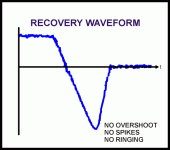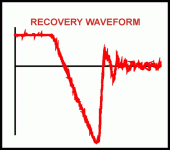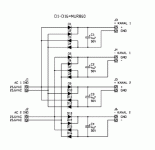nemestra said:It's probably enough. But this a DIY board, and diodes aren't expensive and produce a measurable difference.
James
well this is what the original poster said:
(I know, experimentation is the key, however i'm low on money, so experimentation for now is out of reach .. even if it may be the purchase of extra several diodes which would be under $20, i'd still prefer to keep the extraneous costs down at this time).
a GBU8J (8a 600v) costs about 0.74 a piece (they don't have it in stock), while 4 mur860 ($1.09 a piece x 4 = 4.36 total, or over 6x the cost of gbu8j).
Sure, it may not be expensive by your standard unless someone can clearly articulate the benefit that extra $3+ brings with the murs.
Peter Daniel said:This was directed to Upopa and was still on topic. The way you start posting will surely get the thread off topic.
I thought commenting on a member's past wrongs isn't exactly on topic on this diode discussion?
No?
nemestra said:Rick Miller reported a decrease in rf on the power supply rail in the range of 10-20dB in the frequency range 10kHz to 1.8 MHz when changing from 1N4002 to other types.
James
but that doesn't answer the central question here: does it improve sound?
I mean, if I could get instruments sensitive enough, I could have found that my neutrino shields prevented 99.99% of neutrinos from reaching the transistors. But so what if it doesn't improve sound?
Hi,
From Elliot's site:
"There is currently a trend towards using fast recovery diodes in power supplies, since these supposedly "sound better". This is basically a bad idea, and there is absolutely no requirement for them.
The purpose of a fast recovery (or any other fast diode) is to be able to switch off quickly when the voltage across the diode is reversed.
All diodes will tend to remain in a conducting state for a brief period when they are suddenly reverse biased.
This is extremely important for switched supplies, since they operate at high frequency, and have a squarewave input.
Standard diodes will fail in seconds with the reverse current, since it causes a huge power loss in the diode. "
What you need is soft recovery diodes, not a fast switching diode per se.
So, you start looking for soft recovery types and you find these are fast types as well.
All very logical if you know what they're uses are in industrial
applications.
"At 50 or 60Hz, and with a sinewave input, the slowest diodes in the universe are still faster than they need to be."
Absolutely true...
"Indeed, Nelson Pass suggests that even the standard diodes should be slowed down with paralleled capacitors."
Here's the wording: "slowed down".
You can't slow down a diode switching at 50/60 Hz.
What it should say is that the spikes need to be snubbed to mimick a soft behaviour on the rails.
As is explained below:
"This can be an excellent idea, as it reduces the radiated harmonics from the diode switching. Typically, 100nF capacitors (optionally with a small series resistance) are wired in parallel with each diode in the bridge, and this is quite common with some high end equipment and test gear where minimum noise
is essential."
All very well but you'll need a scope to see how effective your network actually is.
From the above it's easy enough to see the arguement in favour of the ordinary diodes but... Isn't it better to keep the rubbish out in the first place? (RFI/EMI).
I'd like to think so...
It's also true that while these fast, ultra fast and whatever special diodes, are much better behaved, they'd still benefit from a snubber network.
Oh, BTW, Schottky diodes work in a completely different way than regular diodes.
If you find them specced for what you need, I'd go for those any time.
Cheers,
SOFT RECOVERY DIODE OF THE SOFT GLASS TYPE:
From Elliot's site:
"There is currently a trend towards using fast recovery diodes in power supplies, since these supposedly "sound better". This is basically a bad idea, and there is absolutely no requirement for them.
The purpose of a fast recovery (or any other fast diode) is to be able to switch off quickly when the voltage across the diode is reversed.
All diodes will tend to remain in a conducting state for a brief period when they are suddenly reverse biased.
This is extremely important for switched supplies, since they operate at high frequency, and have a squarewave input.
Standard diodes will fail in seconds with the reverse current, since it causes a huge power loss in the diode. "
What you need is soft recovery diodes, not a fast switching diode per se.
So, you start looking for soft recovery types and you find these are fast types as well.
All very logical if you know what they're uses are in industrial
applications.
"At 50 or 60Hz, and with a sinewave input, the slowest diodes in the universe are still faster than they need to be."
Absolutely true...
"Indeed, Nelson Pass suggests that even the standard diodes should be slowed down with paralleled capacitors."
Here's the wording: "slowed down".
You can't slow down a diode switching at 50/60 Hz.
What it should say is that the spikes need to be snubbed to mimick a soft behaviour on the rails.
As is explained below:
"This can be an excellent idea, as it reduces the radiated harmonics from the diode switching. Typically, 100nF capacitors (optionally with a small series resistance) are wired in parallel with each diode in the bridge, and this is quite common with some high end equipment and test gear where minimum noise
is essential."
All very well but you'll need a scope to see how effective your network actually is.
From the above it's easy enough to see the arguement in favour of the ordinary diodes but... Isn't it better to keep the rubbish out in the first place? (RFI/EMI).
I'd like to think so...
It's also true that while these fast, ultra fast and whatever special diodes, are much better behaved, they'd still benefit from a snubber network.
Oh, BTW, Schottky diodes work in a completely different way than regular diodes.
If you find them specced for what you need, I'd go for those any time.
Cheers,
SOFT RECOVERY DIODE OF THE SOFT GLASS TYPE:
Attachments
fdegrove said:The reason these special diodes are chosen for audio is their soft recovery characteristic, not because they're fast switching.
Reading thru this thread i wondered when someone would point this out... important, so i will repeat. It is the soft-recovery that is important, what we want to get rid of is the reverse spike when the diode switches off.
dave
planet10 said:It is the soft-recovery that is important, what we want to get rid of is the reverse spike when the diode switches off.
dave
just wanted to give you some perspective: the reverse spike for a gbu8 is about 5ua at room temperature and 500ua at 125 dgrees?
Guesss what the reverse spike is for mur860?
how about 10ua at room temperature and 500ua at 125 dgrees.
slightly worse than the lowly gbu8.
millwood said:
well this is what the original poster said:
a GBU8J (8a 600v) costs about 0.74 a piece (they don't have it in stock), while 4 mur860 ($1.09 a piece x 4 = 4.36 total, or over 6x the cost of gbu8j).
Sure, it may not be expensive by your standard unless someone can clearly articulate the benefit that extra $3+ brings with the murs.
While cost of 1 bridge isn't lots ($3 for some bridges i saw on digikey, or slightly more if you build one out of separate diodes), i need 3 bridges for my application. That means I pay $15 for each bridge configuration i want to test. So, if i wanted to test mur860s, a bridge, and another type of a diode, i'm $45 poorer.
Now, while $15 doesn't sound like much, when you're on a budget like I am, it is. I learned last time that avoiding extra expenditures is quite important, if i just buy stuff immediately for the sake of testing/having extra components i run out of money fast
One thing to add though, I don't have a problem paying $20 versus $10 if i'm going to get a good improvement in parts (i.e. paying $5 for a bridge vs. paying $1 for a cheaper quality one), however at this stage I can't afford to buy extra components for testing.
I do appreciate all of the responses however (although some are out of my scope of knowledge), so keep them coming.
Btw, thanks peter for that link you posted.
elizard said:While cost of 1 bridge isn't lots ($3 for some bridges i saw on digikey,
$3 a bridge sound like a lot of money. I got a few gbpc 35amp bridges from arrow and they cost like a dollar or two each.
goldmine-elec.com has some 4amp bridges for a dollar each and a 40amp bridge for $2.50 so they may be a cheaper sourcee than digikey.
If my experience is any indication, you wouldn't hear the "improvement" or "difference" one way or the other. But it is fun to try.
Has anyone tried "Stealth" diodes from Fairchild? They are used in switchers for their excellent reverse recovery characteristics. How about SiC (Silicon Carbide) diodes? They are nearly ideal, but cost an amazing amount. They also have high voltage drop.
Personally, I am very skeptical of perceived differences in diodes at 50/60Hz supplies, but I try to keep an open mind.
Tony
Personally, I am very skeptical of perceived differences in diodes at 50/60Hz supplies, but I try to keep an open mind.
Tony
millwood said:
$3 a bridge sound like a lot of money. I got a few gbpc 35amp bridges from arrow and they cost like a dollar or two each.
goldmine-elec.com has some 4amp bridges for a dollar each and a 40amp bridge for $2.50 so they may be a cheaper sourcee than digikey.
If my experience is any indication, you wouldn't hear the "improvement" or "difference" one way or the other. But it is fun to try.
Well, you have to take into account that this is canadian $$$ btw, and sorry, its not $3, its $2.10CDN (or $16 for 10)
Also, when ordering from 2 places as opposed to one (unless i can get a number of components that are cheaper, or a significant discount), the shipping/customs will offset any advantage the discount may have (once again, depending on what the discount is). I like digikey because shipping is $8 flat, and customs are included in the price, so the only thing i pay is 7% tax over top of the order (so a shipment doesn't show up at my door for which i have to pay $50 customs fees!)
Guys, isn't crazy talk about 15 - 20 buck costed rectifiers, which are connected to the cheap 3 - 4 buck amps, which is maded mainly for commercial use ? Isn't it unnecessary ? In this connection will do normal rectifier the same work. Talk about Rf, sound of diodes and similar problems in this " field " is talking about something different thing. It is about right designed PCB and about right designed input filter of amp, 'cos " Rf injection " to the input and input ground is often mainly cause of different sound. I am claiming, that if amp will be maded right in this looks, you can't hear any differences between diodes or rectifiers  .
.
 .
.Tony Salsich said:Has anyone tried "Stealth" diodes from Fairchild?
I tried them briefly, but in GC circuit there was nothing special about them.
I have some $20 bridges fron IXYS, but didn't try them yet. I keep those for a special version of AlephX or SOZ
Elizard, I have some diodes I will never use, so if you are not picky about the type, I could send you some for free.
Hi,
Worse for the MUR8xx?
Not on my datasheets, they're actually exactly the same numbers.
The graphs show different behaviour though.
And once again, the Ir figures are only an indication of one particular aspect of that type of diode.
Nevermind....
Cheers,
Guesss what the reverse spike is for mur860?
Worse for the MUR8xx?
Not on my datasheets, they're actually exactly the same numbers.
The graphs show different behaviour though.
And once again, the Ir figures are only an indication of one particular aspect of that type of diode.
Nevermind....
Cheers,
Peter Daniel said:
I tried them briefly, but in GC circuit there was nothing special about them.
I have some $20 bridges fron IXYS, but didn't try them yet. I keep those for a special version of AlephX or SOZ
Elizard, I have some diodes I will never use, so if you are not picky about the type, I could send you some for free.
peter to the rescue (AGAIN!)
Tell ya what, i'll order normal bridges ($2/piece, i'm allright with paying them), and then maybe i'll take you up on that offer (at least for testing purposes)
while on the subject, i promised some bright blue led's a year ago, and i never sent any
email me your address info if you wish, and i'll send you 15-20 of them
Peter Daniel said:
millwood has been proven wrong on many occasions, but this is not important here. I don't regard Madrigal as DIY and one hit wonder enterprise. With 30 years legacy, they should know what they are doing. Here's a reprint taken from ML380 upgrade literature.
Any clue what diodes used in the Madrigal ???
All the best!
Lyra
No, but maybe you could figure out from those high resolution pics
http://www.marklevinson.com/image_library/index.asp?categoryID=1&productID=15
http://www.marklevinson.com/image_library/index.asp?categoryID=1&productID=15
I use MUR860 diodes in my bridges. When I put 100nF film caps across each diode the sound became much better. I guess that snubbers are quite important here.
I am planning to do a simple AC filter (with a toroidal core and some caps) and also experiment 100nF caps (film/ceramic/MLCC?) from the outputs of the tx to ground.
Miguel
I am planning to do a simple AC filter (with a toroidal core and some caps) and also experiment 100nF caps (film/ceramic/MLCC?) from the outputs of the tx to ground.
Miguel
miguel2
I use MUR860 diodes in my bridges. When I put 100nF film caps across each diode the sound became much better. I guess that snubbers are quite important here.
Which brand/type of 0,1uf filmcaps did you use for this, Miguel?
I bypassed my 1000uF's like on the below pic - with Elna Starget 4,7uf caps.
Should I try both, or are my 4,7uf's doing the same job as your 0,1uf's on each diode...?
/Jan
Attachments
- Status
- This old topic is closed. If you want to reopen this topic, contact a moderator using the "Report Post" button.
- Home
- Amplifiers
- Chip Amps
- Rectifiers for the GC


